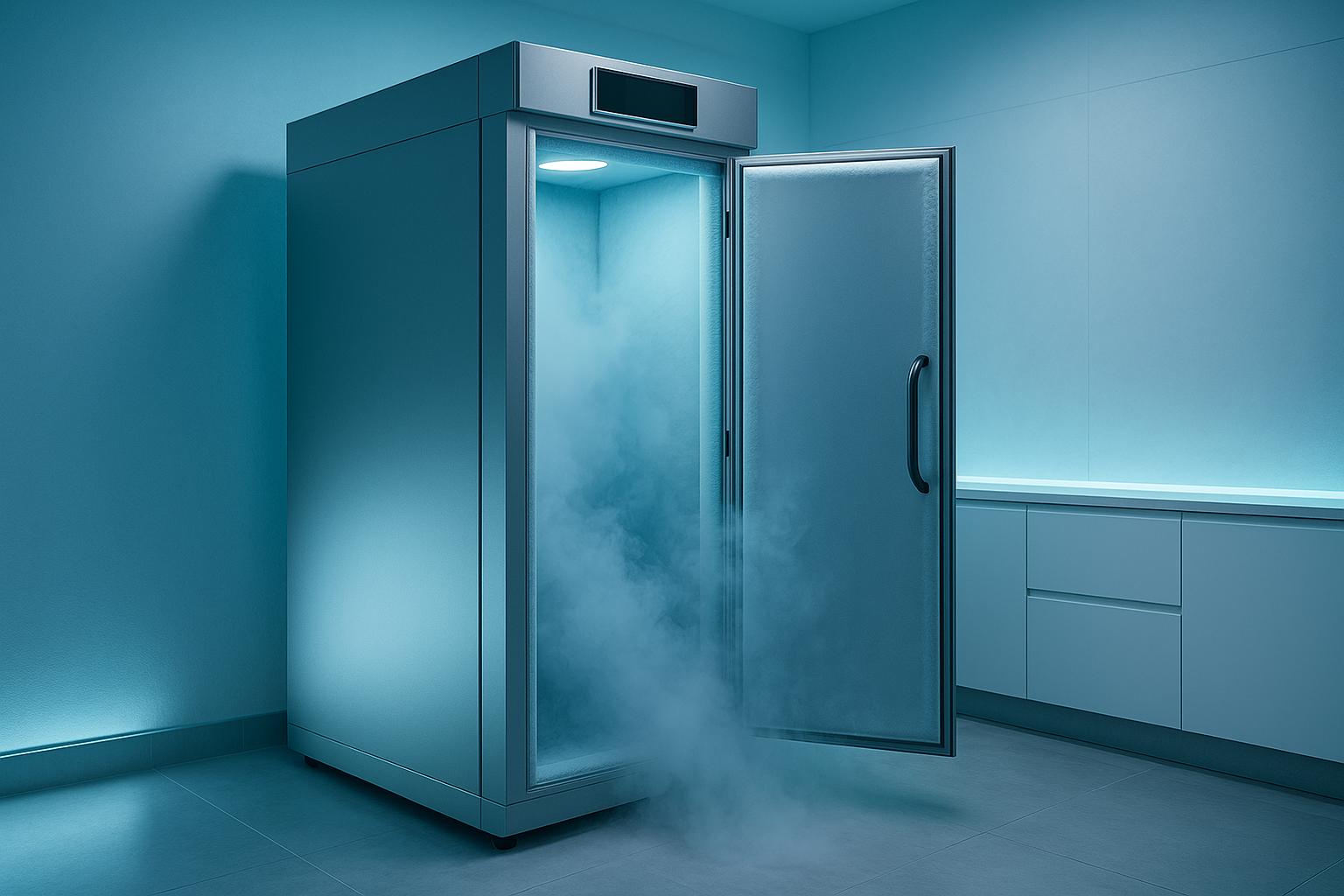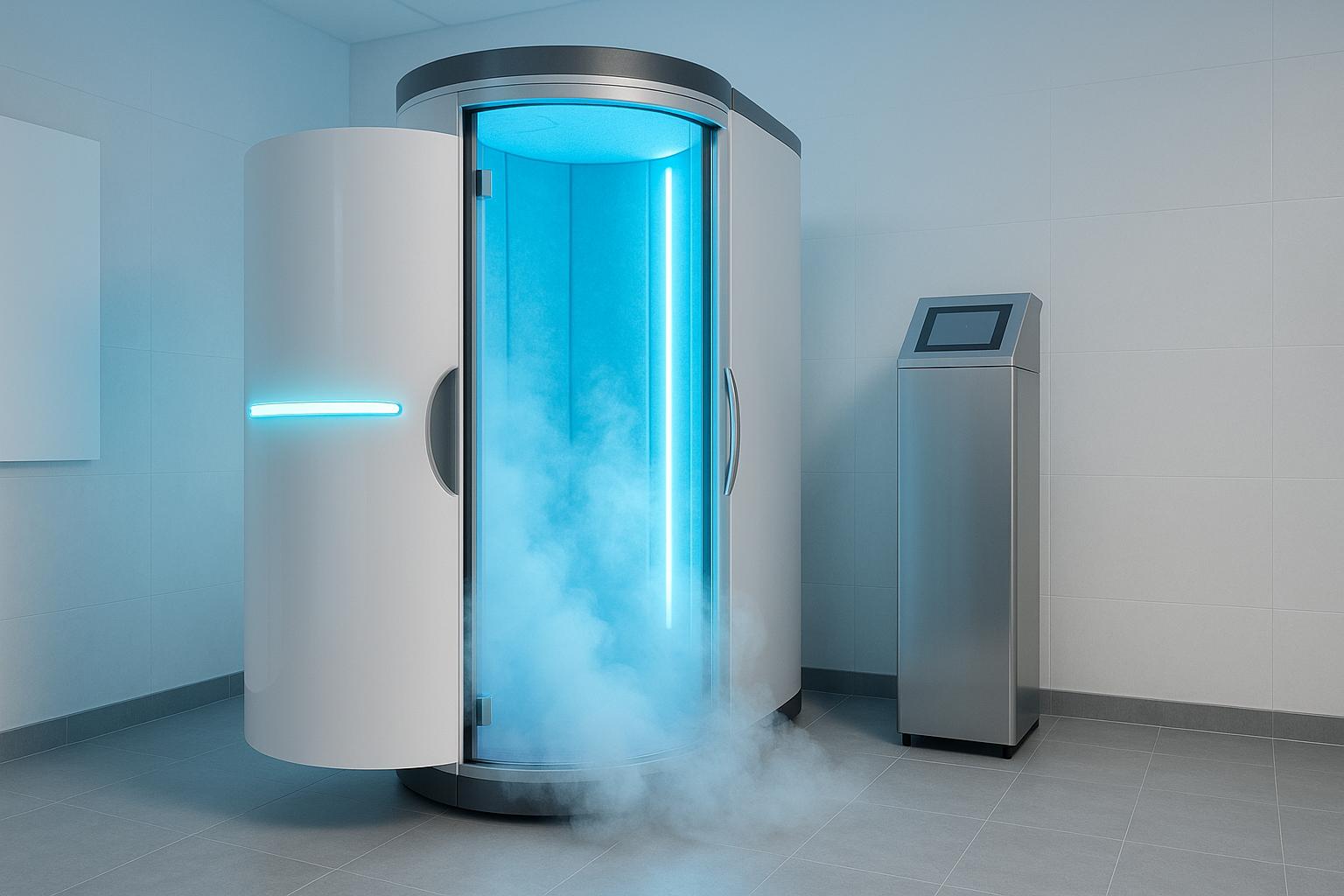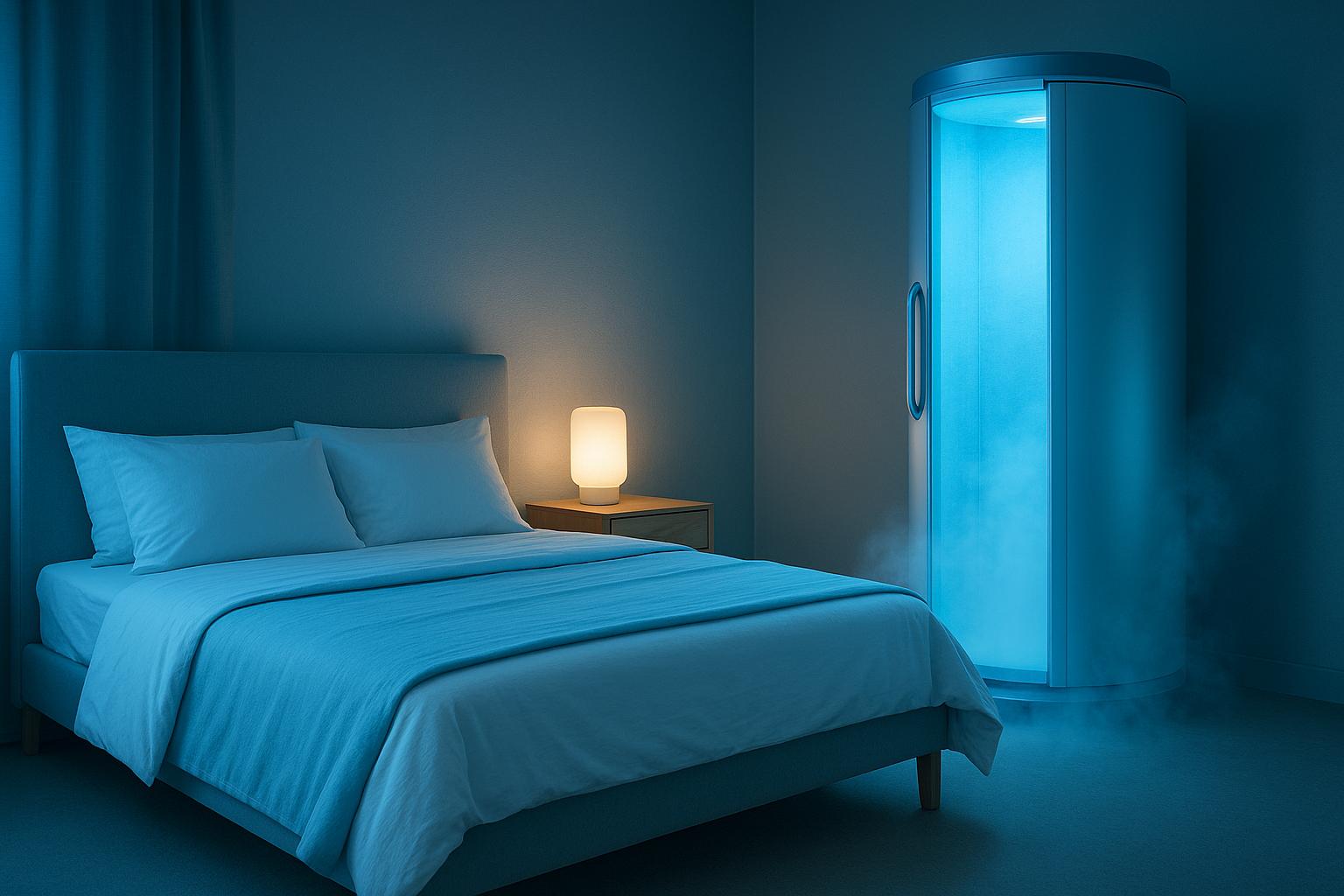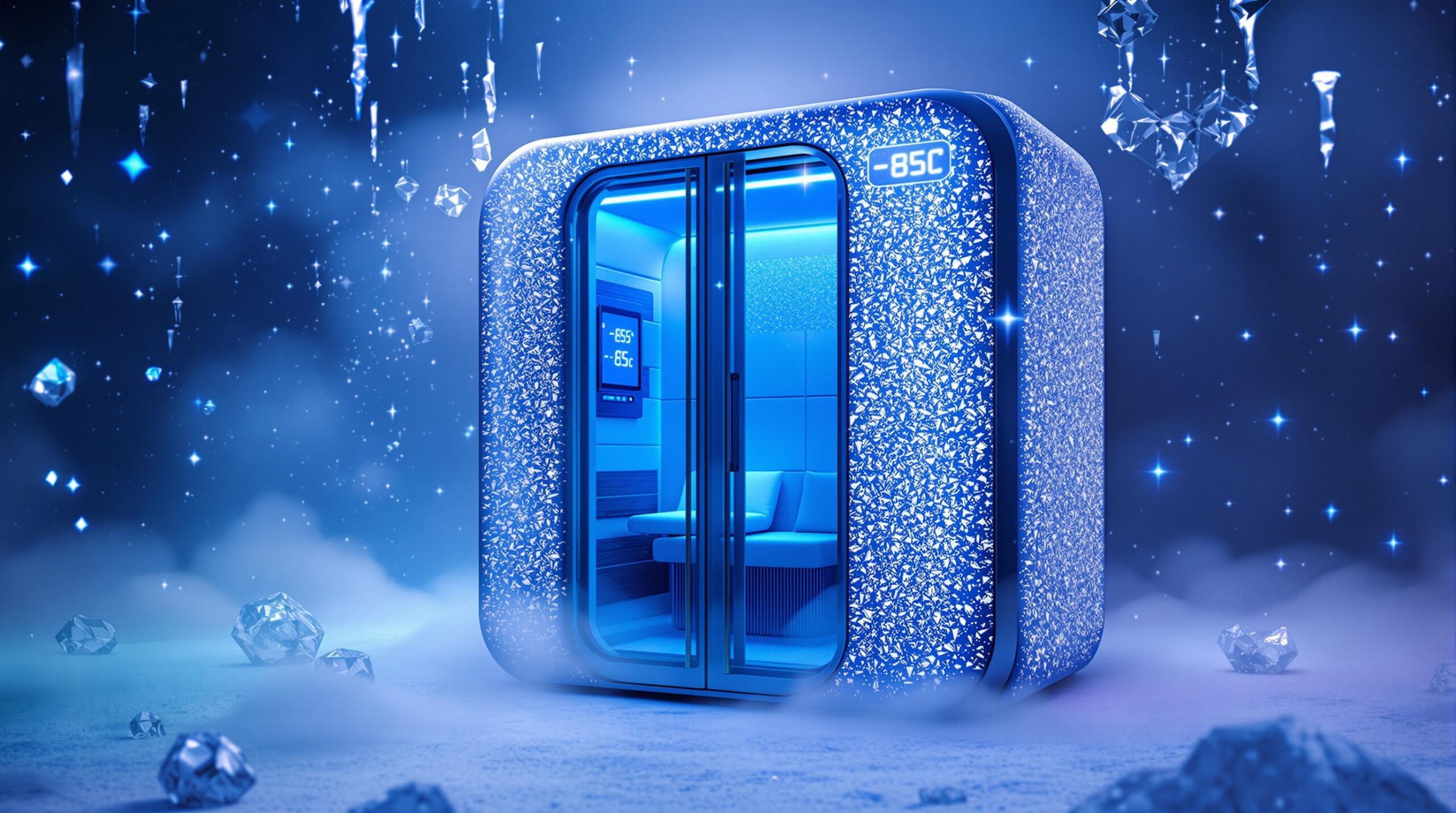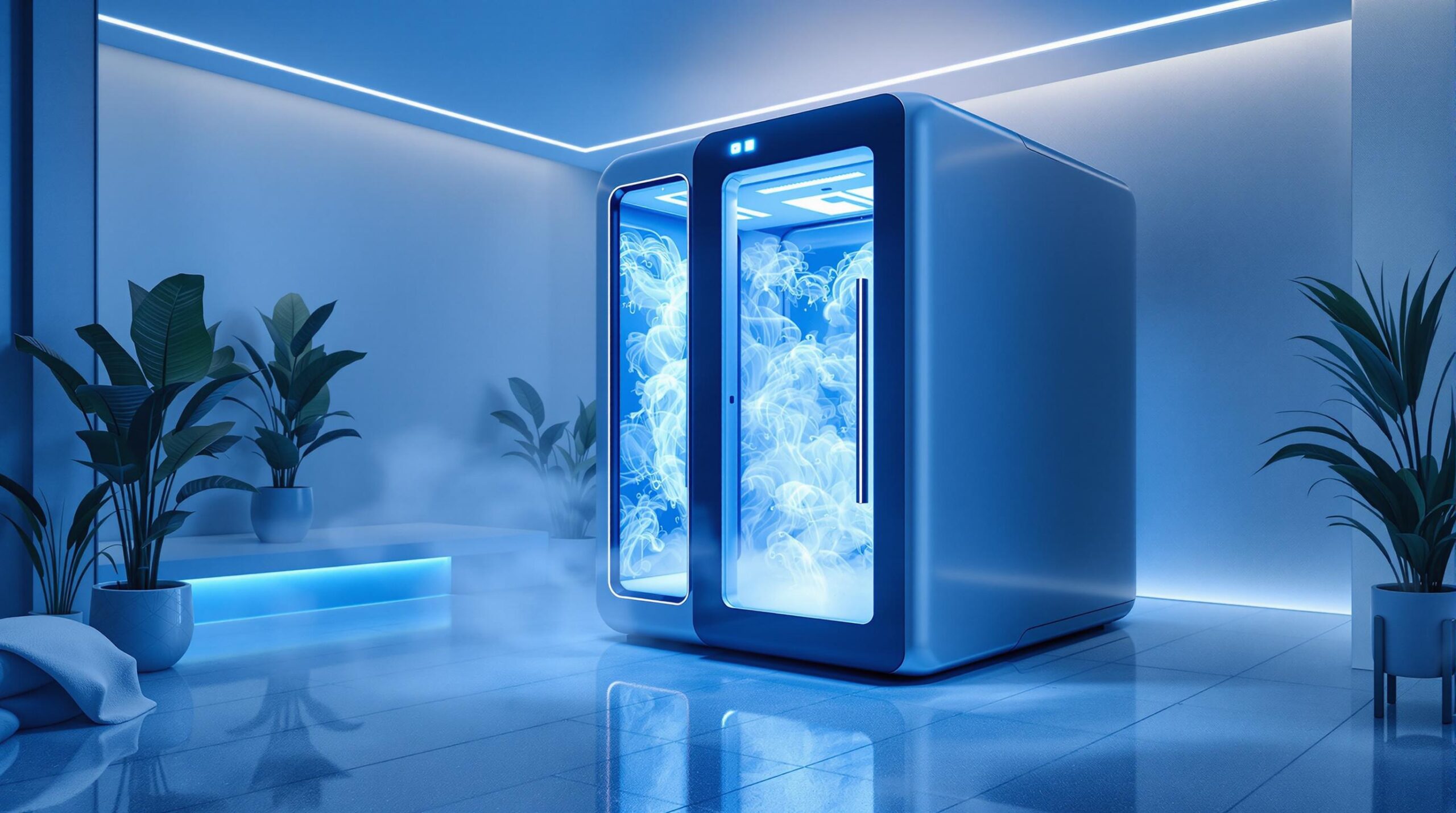Cryotherapy is a recovery technique where athletes are exposed to extremely cold temperatures. At The Cryo Hub Berkhamsted, a state of the art electric Cryochamber means the subject’s entire body – importantly including the head/face – is cooled in temperatures reaching to -85°C, for 3-5 minutes.
It’s widely used to speed up recovery, reduce inflammation, and enhance physical and mental performance. Here’s a quick overview of its benefits:
- Faster Muscle Recovery: Reduces inflammation, alleviates soreness, and promotes blood flow for quicker healing.
- Fighting Inflammation: Minimises swelling and lowers inflammatory markers like C-reactive protein.
- Building Stamina: Improves oxygen delivery, reduces heart strain, and enhances endurance.
- Injury Protection: Strengthens joints, reduces pain, and increases mobility.
- Mental Sharpness: Boosts focus, improves sleep, and balances stress hormones.
Quick Comparison of Recovery Methods
| Method | Temperature Range | Duration | Key Benefits |
|---|---|---|---|
| Cryotherapy | -85°C | 3-5 minutes | Full-body recovery, mental clarity, improved sleep, mood boost, reduced anxiety |
| Ice Bath | 8°C to 15°C | 5–15 minutes | Reduces swelling and soreness |
| Cold Water Immersion | 12°C to 15°C | 5–10 minutes | Targets specific muscle groups |
Cryotherapy offers a safe, efficient recovery option when used under professional supervision. For best results, schedule sessions immediately after exercise or competition.
1. Faster Muscle Recovery
How Cold Affects Muscles
Cryotherapy exposes athletes to extreme cold, triggering critical physiological responses. This intense cold causes blood vessels to constrict, redirecting blood flow to the body’s core to safeguard vital organs. This process, known as vasoconstriction, reduces inflammation and aids in muscle repair. Once the body warms up again, blood flow returns to the muscles, carrying essential nutrients for tissue recovery.
This technique is particularly effective for managing Delayed Onset Muscle Soreness (DOMS), which typically appears 24 hours after intense exercise. During cryotherapy, muscle temperature decreases by 3°C to 8°C, reducing the inflammation responsible for post-exercise pain and swelling. Improved circulation during the rewarming phase helps athletes recover faster, allowing them to maintain their training schedules while minimising the risk of overuse injuries.
The timing of cryotherapy sessions plays a crucial role in maximising these recovery benefits.
Timing Your Sessions
Research highlights the importance of timing for cryotherapy to achieve the best results:
"Cold water immersion cryotherapy for 11–15 min at 11-15°C has a beneficial effect on recovery that is greatest 24 hours after the cryotherapy."
| Method | Temperature Range | Optimal Duration | Best Timing |
|---|---|---|---|
| Whole-Body Cryotherapy | -85°C | 3-5 minutes | Immediately post-exercise |
| Cold Water Immersion | 11°C to 15°C | 11-15 minutes | Within 24 hours post-exercise |
| Local Ice Treatment | Above 0°C | Maximum 10 minutes | Immediately post-exercise |
A study conducted with middle- and long-distance runners at Beijing Sport University found that whole-body cryotherapy (WBC) outperformed other recovery methods. It proved especially effective during high-intensity training phases, pre-competition preparation, and post-competition recovery routines.
However, overdoing it can have negative effects. Sports medicine experts caution:
"Duration is the critical variable in conventional cryotherapy, with prolonged icing leading to immediate detriment in muscle power and activity. Thus, we recommend using ice cryotherapy following exercise for no longer than 10 min for pure hypoalgesia."
To maximise recovery, whole-body cryotherapy should be used within 24 hours of exercise, adhering to recommended exposure times. Exceeding these durations can reduce muscle power and hinder recovery.
2. Fighting Inflammation
Cryotherapy or Ice Bath?
Whole-body cryotherapy (WBC) and ice baths take different approaches to recovery. WBC uses dry, super-cold air for short sessions, while ice baths involve immersing yourself in cold water. At The Cryo Hub in Berkhamsted, Hertfordshire, an advanced cryochamber is used to ensure precise temperature control. Their physiotherapists highlight that WBC’s dry air method avoids the risk of muscle tissue freezing, which can occur with extended cold water exposure.
| Recovery Method | Temperature | Duration | Application |
|---|---|---|---|
| Whole-Body Cryotherapy | -85°C | 3-5 minutes | Before or after exercise |
| Ice Bath | 8°C | Up to 15 minutes | After exercise only |
This level of control sets WBC apart from ice baths and plays a key role in reducing swelling.
Reducing Swelling
Minimising inflammation is essential for quicker recovery and better performance. Studies show that WBC can significantly influence inflammation levels.
When you step into the chamber, the extreme cold triggers vasoconstriction, which helps limit swelling. At the same time, neutrophil counts jump by 114% within an hour. The benefits don’t stop there – C-reactive protein levels stay much lower compared to passive recovery for up to 48 hours after exercise.
For the best recovery results, schedule WBC sessions immediately post-exercise, as well as at 24, 48, and 72 hours. This timing has been shown to reduce muscle soreness and lower creatine kinase levels (P < 0.05).
3. Building Stamina
Energy System Effects
Whole-body cryotherapy (WBC) can help improve athletic endurance through two main processes. First, it causes vasoconstriction, which helps muscles get better oxygen supply. Second, it activates the autonomic nervous system, boosting parasympathetic activity.
Studies have found that WBC sessions enhance muscle oxygenation and reduce cardiovascular strain during intense workouts.
| Performance Metrics | Impact of WBC |
|---|---|
| Oxygen Consumption (VO₂) | Lower at submaximal levels |
| Heart Rate | Reduced during submaximal exercise |
| Tissue Saturation Index | Higher during submaximal and maximal running |
| Perceived Exertion | Noticeably lower compared to control groups |
These changes offer practical benefits for athletes. They experience improved antioxidant defences, less oxidative stress, and more stable heart rate variability. Exposure to extreme cold also triggers hormonal changes, such as higher testosterone levels and lower cortisol levels. Together, these effects lead to measurable performance improvements, which have been highlighted in recent athlete case studies.
Success Stories
A 2015 study by Krueger et al. highlighted the benefits of WBC for long-distance runners. After undergoing three-minute sessions, athletes experienced temperature drops of 8.95°C in the forehead, 13°C in the thighs, and 11.15°C in the arms.
These physiological changes directly impact training and competition performance. For recovery, athletes are advised to schedule three WBC sessions per week after workouts. For competition preparation, a session three hours before the event can enhance performance.
Each three-minute session triggers a strong metabolic response, burning between 500 and 800 calories. This calorie burn, combined with improved oxygen delivery to muscles and reduced strain on the heart, creates a powerful endurance boost that supports both training and competitive performance.
sbb-itb-32603e3
4. Injury Protection
Joint and Muscle Care
Local cryotherapy cools tissues to temperatures between –12°C and –9°C, activating several protective responses. These include raising the pain threshold, increasing tissue viscosity, reducing inflammation, and lowering muscle spindle activity. Together, these effects promote better joint stability and mobility.
However, studies show that if skin or tissue temperature drops too low – below approximately 15°C at the surface – it can actually cause more inflammation and swelling. This highlights the importance of controlled application for effective recovery, especially when paired with physiotherapy.
| Tissue Response | Temperature Effect | Benefit for Injury Prevention |
|---|---|---|
| Pain Threshold | Increased | Greater tolerance during training |
| Tissue Viscosity | Increased | Enhanced joint stability |
| Inflammatory Response | Reduced | Lower risk of injury |
| Muscle Spindle Activity | Decreased | Improved range of motion |
Working with Physio
By leveraging cryotherapy’s protective effects, combining it with physiotherapy can enhance both injury prevention and rehabilitation efforts. At The Cryo Hub in Berkhamsted, physiotherapists collaborate with cryotherapy experts to create tailored treatment plans that support long-term athletic performance.
Cryotherapy works best when integrated with other therapeutic methods:
-
Immediate Post-Training Protocol
Applying cold therapy right after intense training helps to control inflammation and reduce metabolic activity. This is essential for preventing overuse injuries and aiding recovery. -
Joint Mobilisation Benefits
Cryotherapy’s pain-relieving properties make joint mobilisation during physiotherapy more effective. Cooling tissues beforehand often allows for improved range of motion with less discomfort.
For younger athletes with normal sensation, progressive cold water immersion is often beneficial. Older athletes or those with reduced sensation should opt for gentler cooling methods to minimise risks.
All cryotherapy sessions should be conducted under professional supervision to ensure safety.
5. Mental Sharpness
Brain Performance
Cryotherapy has been shown to improve cognitive function, giving athletes a mental edge. Research from the Center for Sports Performance and Research highlights how exposure to extreme cold influences neurotransmitters, leading to better brain performance.
For example, a study involving 18 young adults found that a single 3-minute partial-body cryotherapy session at –150°C significantly improved cognitive inhibition. Participants’ Stroop task response times dropped from 602.0 ± 56.4 ms to 562.0 ± 40.2 ms.
Some of the key benefits to brain function include:
- Boosted norepinephrine levels, which increase alertness.
- Higher endorphin production, leading to better mood.
- Improved parasympathetic activity, ensuring better oxygen flow to the brain.
- Balanced cortisol levels, helping to manage stress.
These mental benefits align with the physical recovery advantages discussed earlier, offering a well-rounded approach to enhancing athletic performance. Additionally, cryotherapy supports restful sleep, which is crucial for both recovery and mental clarity.
Sleep Quality
Good sleep is crucial for peak performance, and cryotherapy has been found to aid restful recovery. French basketball players reported deeper, more restful sleep after undergoing whole-body cryostimulation. Their sleep quality ratings improved from 3.2 ± 0.9 to 3.7 ± 0.7.
In a 2019 study published in the European Journal of Sport Science, 22 physically active men who had evening cryotherapy sessions at –40°C experienced reduced movement during sleep, increased parasympathetic nervous activity, and improved subjective sleep quality.
"This therapy is extremely beneficial for those who struggle with mood disorders like anxiety and depression. Whole Body Cryotherapy involves the use of extremely cold temperatures, which results in physiological hormonal responses. Adrenaline, noradrenaline, and endorphins are released during this process".
For the best results, athletes are advised to schedule one to three cryotherapy sessions per week, particularly after evening training sessions. This routine helps maintain consistent sleep improvements while also supporting recovery and mental sharpness.
Conclusion: Starting Cryotherapy
Key Takeaways
Whole-body cryotherapy (WBC) offers several benefits for athletes:
- Tennis players who used cryotherapy for five consecutive days showed better stroke performance and quicker recovery times.
- Athletes experienced improvements in peak power and overall work capacity after completing 10 WBC sessions.
- Scheduling sessions about three hours before a competition can help improve performance.
- High-level athletes might see results with two to three sessions per week, while recreational athletes could benefit from just one session weekly.
To enjoy these benefits, it’s crucial to stick to proper safety measures.
Staying Safe
The Cryo Hub in Berkhamsted, Hertfordshire, highlights the importance of professional supervision and personalised treatment plans.
"Because the cold involved can shock the system… Cryotherapy should only be applied in controlled and supervised environments like the one we provide at the Center for Sports Performance and Research." – Brian George, Performance Recovery Specialist, Mass General Brigham
Here’s how to get started safely:
- Initial Consultation: Speak with a qualified sports medicine specialist to determine if cryotherapy suits your needs.
- Session Duration: Each session typically lasts between two and four minutes.
- Timing: Plan sessions right after exercise or competition for the best recovery benefits.
- Expert Guidance: Always follow professional advice to ensure treatments are tailored to your goals and health requirements.

